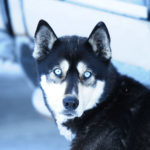FAQ'S for VISITORS
Do NOT bring your dog to any dog race event! For the safety of your furry friends and ours, we DO NOT allow pets of any kind within the staging and race course area (not even those dogs held on a leash) since they can distract competitors.
Best Viewing: come early to the main starting area to get the best viewing spot. While the teams are getting ready for the race, there are some great opportunities to talk with mushers and see their dogs and equipment. Several road crossings along the trails also provide for great viewing opportunities. Above all, stay off the race course at all times.
Etiquette Around the Dogs and the Mushers: be respectful of their space and their time. Our competitors are friendly and love talking about their dogs and this sport, but they’re also nervous and may be a little amped up about the upcoming challenge. Getting a team ready to go takes a lot of work and at times they may not be able to talk. Please ask permission before touching any sled dogs – before, during or after the race. Never attempt to feed a sled dog.
Photo Ops: ask the musher before taking your best selfie with them or their dogs. Most of the time they will gladly pose with you. If you keep a respectful distance and aren’t in the way of their preparatory chores, you’ll find some amazing images to capture! The dogs are charismatic and their personalities and silly quirks are always on display.
For that very special photo, look for the dogs with blue eyes.
Best “Wilderness” Photos: put on your mukluks, grab your best zoom lens and stake out a spot somewhere away from people and OFF the trail. The best shots we see each year are often taken from somewhere “in the trees”. It gives a feel of the surroundings while prominently featuring the dog team making their way along the trail. We ask that you not inadvertently do anything to spook the dogs as they are maneuvering along the trails.
Best Photos/Video: the best vantage point to photograph from is along the outside portion of the “orange” starting chute. But stay OFF the trail itself as it is dangerous when the teams take off at top speed! Allow a safe distance when the musher brings their dogs into the starting chute. Again, common sense and a respectful distance will make it a great experience with great photos. Go ahead and cheer on your favorite teams — these dogs love to work, and the louder you cheer, the faster they run!
Parking: it’s always at a premium, and we reserve a lot of space specifically for dog trucks, the veterinarian team, race officials and sponsors. Plan on walking along the outside hub of the action, not parking right next to it.
Why do the dogs look so different? you’ll see all kinds of breeds competing. Shorter coated dogs that are lean and long-legged are usually called Alaskan Huskies or open class dogs. They have been bred very specifically for what they do: running in cold weather at the fastest speeds possible. This breed is not a purebred but rather a dog with many bloodlines carefully bred into it. You will also commonly see purebred Northern breeds; dogs most people expect to see when they think of a dogsled race. These are mainly Siberian Huskies however the Alaskan Malamute, Canadian Eskimo Dog and Samoyed are all considered Northern breeds that have been used as sled dogs for centuries. Skijoring classes typically feature an even wider array of breeds. Be on the lookout for everything from Golden Retrievers to Border Collies!
Teams are constantly coming and going, how do I know who’s winning? mushers leave the start chute at two minute intervals and race against the clock. The teams leave the start chute based on a random draw for bib numbers the night before. Upon completion of the race, winners are decided by determining the time they needed to complete their specific race event.
How do mushers control their teams? A dog team is controlled through voice commands. Every kennel has a slight variation in their commands but in general, Gee is for right and Haw is for left. Hike means go, and On-By means to ignore something. Whoa, of course, means stop. If you hear a musher yell Trail, this means the team in front of them should pull over and let them pass. The sled is controlled by the musher shifting their weight as well as using the sled brake. Mushers start training their teams in the fall as soon as the temperature begin to cool, so by the time snow is on the ground, mushers already have many miles on their dogs. These dogs are real athletes and are in incredible physical shape.






